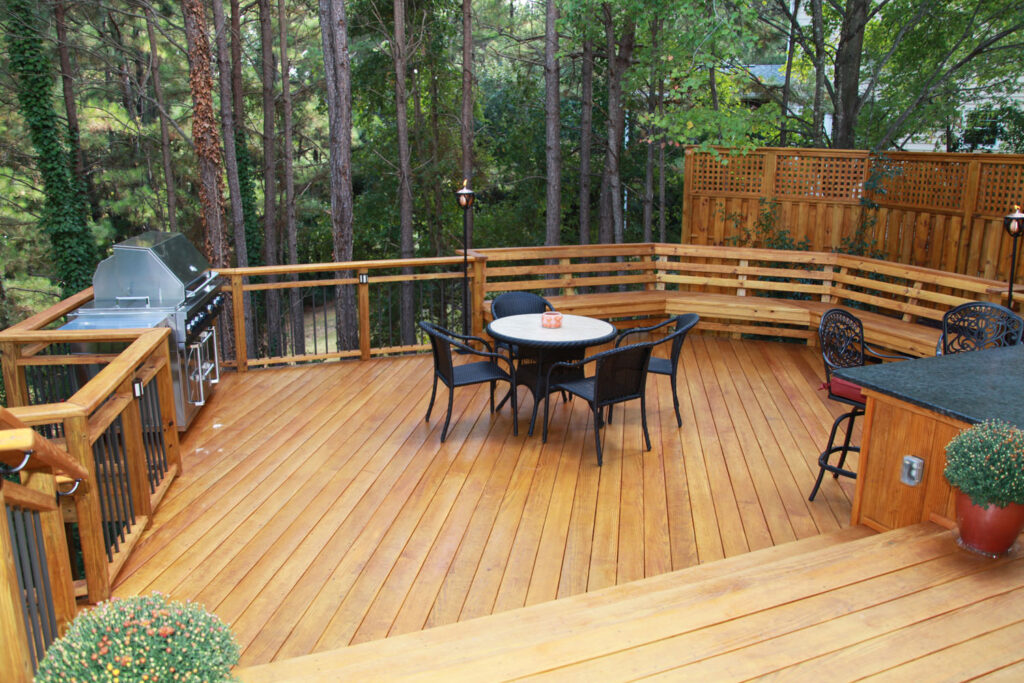Legno reale vs. decking composito o in plastica
VERO LEGNO vs
Decking composito
Mentre alcuni proprietari di case e costruttori optano per un piano di calpestio composito o in plastica, il pino meridionale trattato a pressione è ancora la scelta più popolare per una serie di motivi.
Bellezza, valore aggiunto e comfort sono solo alcuni dei motivi per cui i ponti e i portici Southern Pine sono così popolari, per non parlare di queste “stanze all’aperto” che estendono lo spazio abitativo di una casa per l’intrattenimento e il relax all’aria aperta.
Ma le tavole del decking, la superficie di calpestio del ponte, hanno un lavoro duro. Il decking subisce dure punizioni quotidiane dalle condizioni atmosferiche e dal traffico pedonale e, essendo la parte più visibile del ponte, deve soddisfare elevate aspettative di vestibilità, finitura e aspetto a lungo termine.
Il legno è la scelta ambientale migliore per i progetti all’aperto
, poiché altri prodotti per decking possono richiedere fino a otto volte più energia per essere prodotti rispetto al legno.
Il legno massello è un prodotto coltivato naturalmente e rinnovabile, a differenza dei compositi che di solito sono realizzati con materiali a base di petrolio come polietilene, polipropilene, polistirene o cloruro di polivinile.
Se stai cercando di decidere tra il decking Southern Pine o un’opzione in plastica/composito, considera quanto segue:
- Estetico
- Costo
- Durabilità
- Impatto ambientale
- Longevità
- Manutenzione
In definitiva, la scelta tra decking in legno e composito dipende dalle tue priorità e preferenze. Se apprezzi un’estetica naturale e sei disposto a investire tempo nella manutenzione, il decking in legno potrebbe essere la scelta giusta.

| Question | Real Wood | Composites or Plastics | What are the facts? |
|---|---|---|---|
| Natural Appearance? | Yes | No | There is no substitute for the look and feel of real wood. Wood decking looks warm, natural, and blends beautifully with the landscape. Plastic or plastic composites, even with faux wood grain, still look and feel artificial. |
| Comfortable under foot? | Yes | ? | Wood is a naturally insulating material and does not conduct heat or cold like metal or plastic. In direct sun, some plastic or composite decking can become much hotter than wood, hot enough to burn or blister feet. |
| Safe to use? | Yes | Yes | Pressure-treated wood is safe for people, pets, and the environment. Furthermore, advanced preservative formulations contain no arsenical or chromium compounds while being resistant to decay and termite attack. |
| Renewable? | Yes | No | Wood is the only building material that uses the sun’s energy to renew itself in a continuous cycle. Sustainable forestry practices ensure our supply of homegrown wood will be maintained for future generations. On the other hand, plastics are derived from finite petroleum resources. |
| Earth-friendly? | Yes | No | Manufacturing wood products uses less energy and produces less air and water pollution than other building materials. Manufacturing plastic decking requires more energy to produce than a comparable piece of wood decking. |
| Strong? | Yes | No | Wood can be up to four times stronger than plastic or composite products and possesses up to nine times the stiffness of artificial decking. Wood decking is not affected by heat, which tends to promote creep (sagging) in composites over time. |
| Needs maintenance? | Yes | Yes | Despite claims to the contrary, all decking requires maintenance. Periodic cleaning and application of a water-repellant sealer is all that is needed to keep a wood deck in top shape. A good scrubbing usually removes most stains on wood decking, too. |
| Decay/termite warranty? | Lifetime limited | Limited | Wood preservative manufacturers typically offer a limited lifetime warranty against decay and termite attack in residential use. Plastic or composite deck manufacturers typically offer a limited warranty. |
| Standardized product? | Yes | No | Approved inspection agencies monitor lumber production and pressure-treating facilities. These agencies operate under rigorous protocols to enforce uniform performance and quality standards approved by the American Lumber Standard Committee and/or the American Wood Protection Association. |